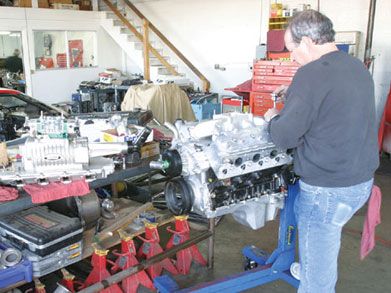
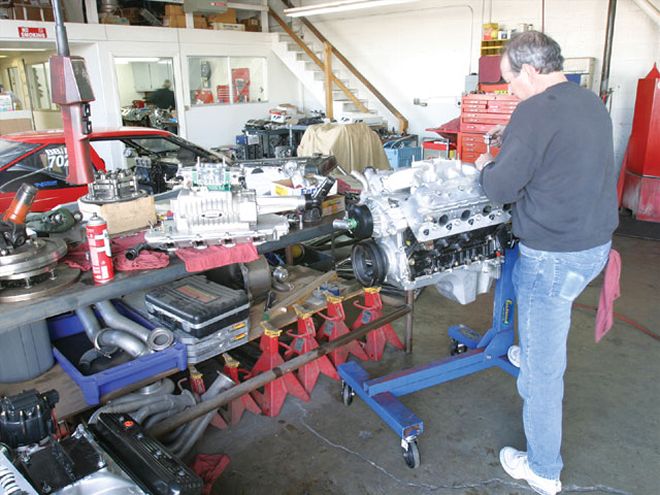 <strong>Here's the recipe: </strong>Take one used 5.3L short-block, add a set of CNC-ported heads, stir in a hydraulic roller cam, sprinkle in a Magnuson supercharger, spice it up with E85 fuel, cook heavily, and serve up a hot 625 hp.
<strong>Here's the recipe: </strong>Take one used 5.3L short-block, add a set of CNC-ported heads, stir in a hydraulic roller cam, sprinkle in a Magnuson supercharger, spice it up with E85 fuel, cook heavily, and serve up a hot 625 hp.
This is the age of horsepower. Power masters build giant-cube big-blocks and play with exotic CNC-machined billet blocks with custom bore centers, tomato can-sized bores, and yard-length strokes. But on the other end of the scale is a new army of small-displacement production V-8 engines capable of amazing power numbers. Back in the Apr. '08 issue ("Add 120+ HP"), we rescued a 5.3L truck engine orphan out of the junkyard and made 433 hp, a gain of 97 hp with just an intake, a carburetor, headers, and a cam. Then we bolted on a set of West Coast Racing Cylinder Heads-ported (WCRCH) stock 5.3L heads and made 449 hp. Finally, we added a set of WCRCH CNC'd Edelbrock heads, and the power jumped to 460. We made this power from a used and totally stock rotating assembly, displacing a mere 325 ci. Little motors rely on rpm to generate horsepower numbers like this, and this effort was no different, spinning 6,700 rpm. This is great power, but we weren't satisfied.
Then we heard rumors of big horsepower attained by bolting one of Magnuson's superchargers to 5.3L truck engines. So we decided on a carbureted Car Craft version using a Magnuson 122 supercharger. As the plan came together, we knew we'd need a different camshaft to take maximum advantage of the supercharger, but other than degreeing-in the cam, that was about the extent of our internal engine modifications. We also retained the CNC-ported Edelbrock heads because their added airflow would really make our 5.3 motor shine.
We'll run through all the details on this test, and after you've digested the data, you'll see what a little motor with a simple supercharger can do on both 91-octane pump gas and a large shot of alcohol. If 1.9 hp/ci sounds interesting, read on.
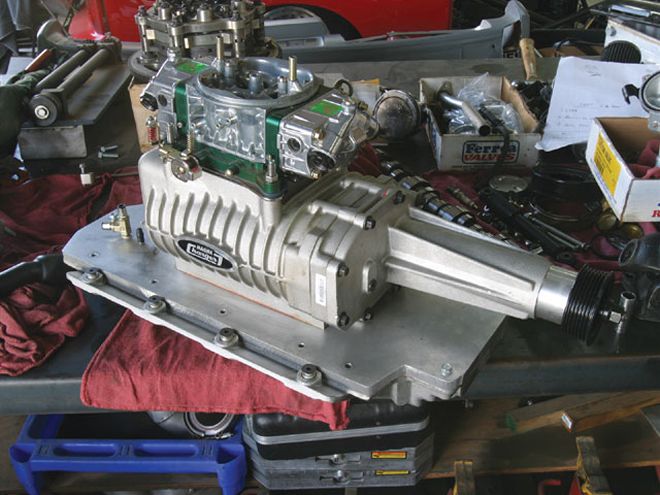 What never ceases to amaze us is how this tiny Magnuson 122ci supercharger can make such awesome power. It's not much bigger than a loaf of bread. Eaton is now in full production on the more efficient TVS supercharger, which will make even more power.
What never ceases to amaze us is how this tiny Magnuson 122ci supercharger can make such awesome power. It's not much bigger than a loaf of bread. Eaton is now in full production on the more efficient TVS supercharger, which will make even more power.
Parts in 5.3 Pieces
In the April test, we relied on a long-duration camshaft, a good set of cylinder heads, and lots of rpm to make 460 hp. This month, we refined that combination to bring the peak horsepower rpm point down with more conservative camshaft timing. The specs can be found in the Cam Specs chart, while all the other valvetrain components (except the valvesprings) were retained, including the rocker arms and pushrods from the previous flogging. Comp has introduced a new, stiffer beehive spring that we wanted to try, which increases the over-the-nose pressure to keep the valvetrain happy. To keep the supercharger testing simple, we retained the WCRCH CNC-ported Edelbrock heads fitted with 2.00/1.57 valves in a fully CNC-machined combustion chamber. Of course, the big change was the Magnuson 122ci carbureted supercharger.
We also retained the Hooker 1 3/4 engine-swap headers along with a pair of Flowmaster 2 1/2-inch mufflers from the previous test to minimize the variables. But in hindsight, it's more than likely that a 3-inch exhaust system (or open headers) would have unleashed even more power. Again, we controlled ignition timing with an MSD LS1/LS6 timing controller. Compression also remained the same at 9.5:1.
You may remember that our first foray into the world of the Magnuson superchargers was with a Gen I 355ci, cast-piston, 8.2:1-compression motor with iron Vortec heads. That simple little motor made 504 hp on pump gas in the Sept. '06 issue ("Big Power From a Little Blower"). This Gen III motor would make much more.
CAM SPECS CAMSHAFT DURATION (Adv.) DURATION (0.050) LIFT LOBE SEPARATION (degrees) (degrees) (inches) (degrees) Comp Cams, intake 273 224 0.581 114 XER273HR-14, exhaust 279 230 0.592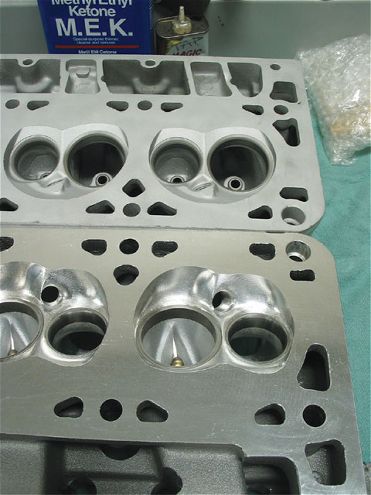 In the Apr. '08 issue, we tested two sets of WCRCH-ported heads: the 5.3 production castings (top) and the CNC-machined Edelbrocks (bottom). The Edelbrock castings use a slightly larger 2.00-inch intake valve compared with the ported 5.3 versions. Both use the same size 1.57-inch exhaust valve.
In the Apr. '08 issue, we tested two sets of WCRCH-ported heads: the 5.3 production castings (top) and the CNC-machined Edelbrocks (bottom). The Edelbrock castings use a slightly larger 2.00-inch intake valve compared with the ported 5.3 versions. Both use the same size 1.57-inch exhaust valve.
Runnin' on AlcoholOne limitation of any supercharged engine is the octane rating of the fuel. Basically, almost any supercharged pump-gas engine will respond with more power by using a higher-octane fuel, which allows the engine tuner to dial in maximum boost and optimize the ignition timing. With current pump premium at a mere 91 octane in California, this is a significant limitation. Sure, we could pump that up with 100-octane unleaded race gas, but we decided instead to load it up with E85 that sports roughly a 105-octane rating if the ethanol and fuel have been mixed properly. In past supercharged dyno adventures, we've seen major power increases from this renewable resource fuel.
If you recall, back in the Feb. '07 issue ("E85 Pump Gas"), we bolted one of these little superchargers on a 10.2:1-compression, 355ci, Gen I small-block Chevy with TFS 210cc heads running E85 and it made a stout 601 hp. Supercharged (and turbocharged) engines are where this ethanol-based fuel really shines because it offers both a high octane rating along with a high latent heat of vaporization (see sidebar), which-when combined with boost pressure-can produce serious horsepower numbers. Even though our current 5.3L engine is an honest 30 ci smaller, the Gen III engine's superior valve angle and excellent airflow numbers (especially the exhaust side) foreshadowed better horsepower numbers.
Evaluating The Numbers
In case you haven't jumped ahead to peek at the power curves, on pump gas this little 325ci managed to crank out an excellent 562 hp at 6,400 rpm with a maximum boost of just a touch more than 10 psi around peak torque and 8 psi at peak horsepower. This neo-327 also pumped out an excellent 514 lb-ft of torque peak and never made less than 456 lb-ft of torque. We tried more timing, but a max of 19 degrees was the limit on 91-octane gasoline. Consider that this is a simple, cast-piston 5.3L engine. That makes this 562 hp even more impressive, equating to 1.73 hp/ci. Not bad for a tuned-up truck engine.
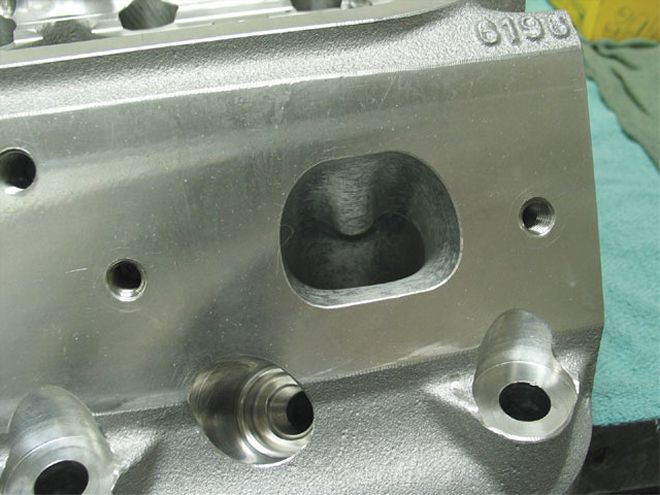 Where the WCRCH-ported Edelbrock heads really shine is on the exhaust side. These heads offer an average exhaust-to-intake flow relationship of more than 80 percent. With a blower shoving air and fuel in, a strong exhaust port will make more power at higher engine speeds.
Where the WCRCH-ported Edelbrock heads really shine is on the exhaust side. These heads offer an average exhaust-to-intake flow relationship of more than 80 percent. With a blower shoving air and fuel in, a strong exhaust port will make more power at higher engine speeds.
Our last magic trick involved replacing the Holley 750 gasoline carburetor for a Quick Fuel 850-cfm E85-version fuel mixer. Then we merely filled the dyno gas tank with 105-octane E85 and began playing with boost and adding timing. The higher octane allowed us an additional 5 degrees of ignition timing (to 24 total) while also adding 1 to 2 more pounds of boost. That may not sound like much, but this was worth as much as 102 more lb-ft of torque at 3,000 rpm over the gasoline-fed version. This massive torque gain is because at lower engine speeds, there's more boost and more time for the fuel to cool the air. Remember, this little blower is only 122 ci. This is why the boost trails off at the higher engine speeds.
From 3,000 rpm up, the E85 delivers a consistent 60-plus horsepower over the 91-grade pump gas. Peak power jumped to 625 hp at 6,400, and there's probably more waiting to be uncovered. If 625 hp and 592 lb-ft of torque doesn't impress-check your pulse.
Latent Heat Of Vaporization
One of the big advantages of running E85 with a supercharger is alcohol's ability to chill the incoming air. This phenomenon is called a liquid's latent heat of vaporization. As an example, if you spread rubbing alcohol on your skin, when the alcohol evaporates, it pulls heat away from your body. Creating a change in state from liquid to vapor at a constant temperature requires energy, which feels like a cooling sensation on your skin as heat (energy) is removed. Because we have to use roughly a 25- to 30-percent greater volume of E85 (85 percent ethanol) compared with gasoline, and since ethanol has a higher latent heat of vaporization, it can drastically lower the inlet air temperature compared with gasoline.
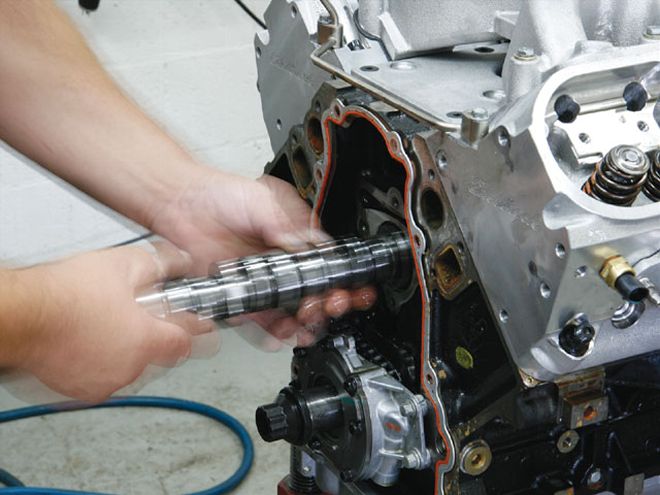 Besides the blower, the only major change to the engine was to a Comp supercharger cam with a wider lobe-separation angle. The hardest part of swapping cams on a Gen III engine was pulling the harmonic balancer. The rest was easy.
Besides the blower, the only major change to the engine was to a Comp supercharger cam with a wider lobe-separation angle. The hardest part of swapping cams on a Gen III engine was pulling the harmonic balancer. The rest was easy.
Now let's add the fact that superchargers heat the air as it is compressed, often driving up the temperature by 80 degrees or more over the ambient inlet air temperature. Even pressurized, hot air is less dense than cool air at equal pressure. If we substitute E85 as a fuel, the large volume of fuel combined with its excellent latent heat of vaporization drastically reduces the discharge temperature from the supercharger. This greater density provides additional power even at the same boost pressure because more oxygen molecules are packed into each cubic foot of air pushed into the cylinders. Plus, the air temperature entering the cylinder is cooler, reducing the engine's sensitivity to detonation. Now add in the benefit of a 105-octane fuel on top of that, and you can see why supercharged engines really like running on E85. This is the same basic reason why the '60s turbocharged IndyCars used methanol.
To put this into perspective, a typical 8-71 supercharged, gasoline-fed engine at 10 psi of boost could easily see an intake manifold air temperature under the blower (depending on the blower's efficiency) of 150 degrees F or higher. In comparison, on a recent Gen I small-block test, a 122ci Magnuson supercharger at 10 psi using E85 fuel recorded an intake manifold temperature of 90 degrees. If you accept the old rule of thumb that power improves 1 percent for every 10-degree reduction in inlet air temperature, just this air temperature reduction alone is worth 6 percent of power. At a 500hp level, that's 30 hp. Plus, with E85 you have the luxury of running idealized ignition timing because of E85's higher octane rating. The combination of these two factors is why this 5.3L engine made roughly 60 more horsepower on E85 versus 91-octane gasoline throughout virtually the entire power curve from 2,000 to 6,400 rpm.
Dragstrip Simulation
Just for fun, we thought it would be interesting to compare this little supercharged 5.3L on E85 fuel with that oval-port 496ci Rat test we completed back in the Mar. '08 issue ("Big-Block Cylinder Head Test"), where the best peak horsepower oval-port head was the Brodix combination that made 597 hp. Using the Quarter, Pro version dragstrip simulation software, we plugged these two completely different engines into a 3,600-pound Chevelle with a 3.55 rear gear, TH400 trans with a 3,000-stall speed converter, and enough tire in the rear to minimize tire spin. We also used the same atmospheric conditions for each to keep the test as fair as possible.
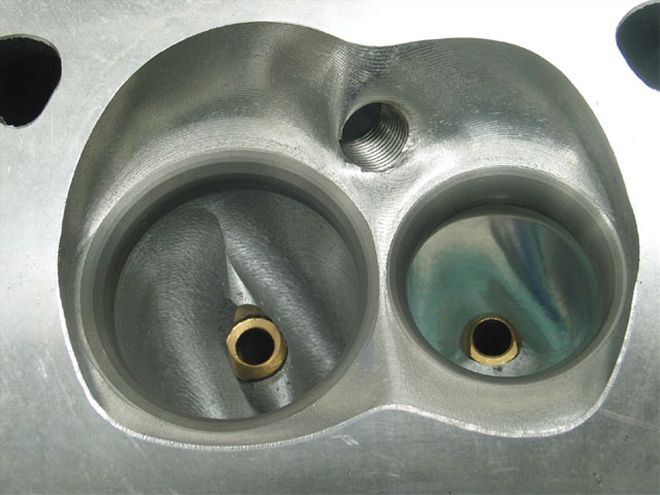 The Edelbrock heads also benefit from a CNC-machined combustion chamber that enhances combustion efficiency.
The Edelbrock heads also benefit from a CNC-machined combustion chamber that enhances combustion efficiency.
While the Rat would seem to have an advantage, the simulation showed that the two completely different combinations ran within 0.09 second of each other with a slight advantage going to the 5.3L combination. According to our simulation, the 496 oval-port Rat would run 10.94 at 123 mph, while the supercharged 5.3L on E85 simulated a 10.85 at 123.8 mph. We didn't reduce the weight of the small-block combination compared with the Rat nor did we optimize the gear ratio with either version, despite the fact that the small-block cleared the lights at only 5,860 rpm, well below its 6,400-rpm peak horsepower rpm. One reason this blown Gen III runs so quick is its amazing average torque. Sure, horsepower is good, but in a heavy car, that average torque rating of 567 lb-ft helps move the car.
Our experience with the Quarter, Pro program is that it predicts e.t.'s that are about 0.20 second and 2 mph quicker and faster than our best on-track efforts, and there are probably many good tuners who could run these simulated times. This won't persuade any Rat motor true believers to trade in all their porcupine parts for Gen III stuff, but it does show there are plenty of ways to go fast.
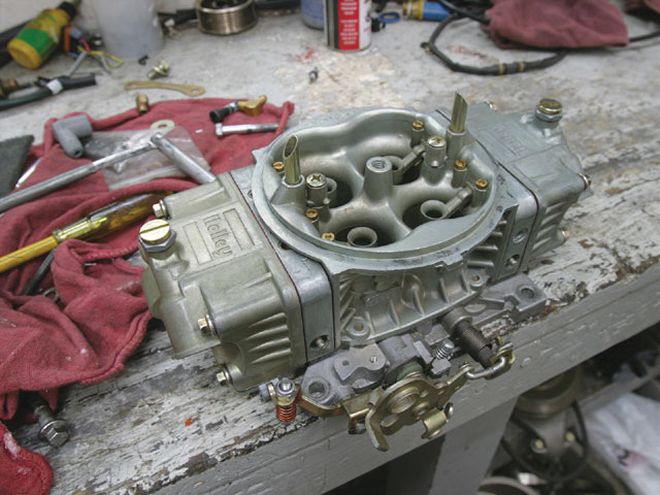 The first gasoline tests were run with a Holley 750-cfm supercharger carburetor on top of the Magnuson 122 supercharger.
POWER CURVE TEST 1 TEST 2 DIFFERENCE RPM TQ HP BOOST TQ HP BOOST TQ HP (PSI) (PSI) 2,000 456 173 8.0 521 199 10.1 65 26 2,{{{200}}} 465 195 8.7 536 224 10.6 71 29 2,400 468 214 9.1 549 251 11.2 81 37 2,{{{600}}} 470 233 9.5 562 278 11.6 92 45 2,800 473 252 9.7 572 305 12.0 99 53 3,000 478 273 9.9 580 332 12.2 102 59 3,200 484 295 10.1 586 357 12.4 102 {{{62}}} 3,400 491 318 10.2 589 381 12.4 98 63 3,600 498 341 10.3 591 {{{405}}} 12.4 93 64 3,800 504 365 10.3 592 428 12.4 88 63 4,000 509 387 10.2 592 451 12.2 83 64 4,200 512 409 10.1 592 474 12.1 {{{80}}} 65 4,400 514 430 9.9 591 496 11.8 77 66 4,600 514 450 9.7 590 517 11.6 76 67 4,800 514 470 9.5 587 536 11.3 73 66 5,000 512 488 9.2 582 554 10.9 70 66 5,200 510 {{{505}}} 9.0 575 569 10.6 65 64 5,400 505 519 8.9 566 582 10.4 61 63
The first gasoline tests were run with a Holley 750-cfm supercharger carburetor on top of the Magnuson 122 supercharger.
POWER CURVE TEST 1 TEST 2 DIFFERENCE RPM TQ HP BOOST TQ HP BOOST TQ HP (PSI) (PSI) 2,000 456 173 8.0 521 199 10.1 65 26 2,{{{200}}} 465 195 8.7 536 224 10.6 71 29 2,400 468 214 9.1 549 251 11.2 81 37 2,{{{600}}} 470 233 9.5 562 278 11.6 92 45 2,800 473 252 9.7 572 305 12.0 99 53 3,000 478 273 9.9 580 332 12.2 102 59 3,200 484 295 10.1 586 357 12.4 102 {{{62}}} 3,400 491 318 10.2 589 381 12.4 98 63 3,600 498 341 10.3 591 {{{405}}} 12.4 93 64 3,800 504 365 10.3 592 428 12.4 88 63 4,000 509 387 10.2 592 451 12.2 83 64 4,200 512 409 10.1 592 474 12.1 {{{80}}} 65 4,400 514 430 9.9 591 496 11.8 77 66 4,600 514 450 9.7 590 517 11.6 76 67 4,800 514 470 9.5 587 536 11.3 73 66 5,000 512 488 9.2 582 554 10.9 70 66 5,200 510 {{{505}}} 9.0 575 569 10.6 65 64 5,400 505 519 8.9 566 582 10.4 61 63
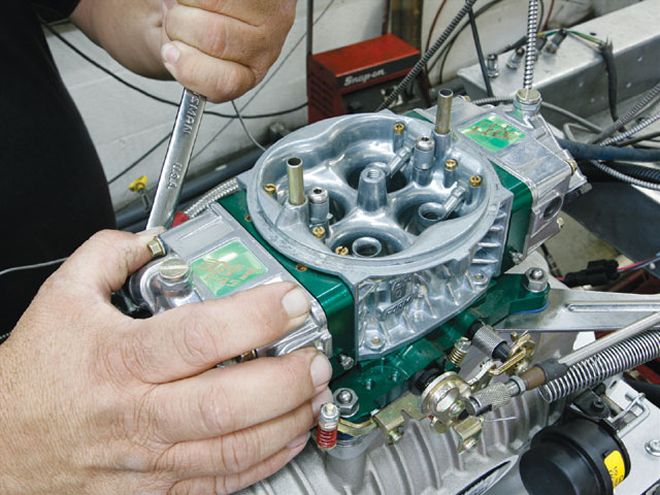 The conversion to E85 was really easy, since all we had to do was swap carburetors to a Quick Fuel 850 and pour in the E85. Our fuel was supplied by our friends at Innovate Motorsports, who also supplied the air/fuel ratio meter we used to help tune the package.
5,{{{600}}} 499 531 8.7 555 592 10.1 56 61 5,800 490 541 8.5 544 602 10.0 54 61 6,000 480 548 8.4 534 611 9.9 54 63 6,{{{200}}} 471 556 8.4 525 620 9.9 54 64 6,400 461 562 8.4 513 625 9.8 52 63 Peak 514 562 10.3 592 625 12.4 Avg. 491.9 390.7 9.4 567.6 452.6 11.2
PARTS LIST DESCRIPTION PN SOURCE PRICE Magna {{{Charger}}} carbureted custom Magnuson $3,195.00 - 3,695.00 WRCH CNC-ported head EDL-200 WRCH 2,150.00 Comp Gen III blower cam 54-444-11 {{{Summit}}} Racing 369.99 Comp beehive springs 26928 Summit Racing 306.39 Holley 750-cfm carb 0-805753S Summit Racing 559.95 Quick Fuel E85 carb Q850-E85 Quick Fuel 778.95 Hooker 13/4-inch headers 2288-1HKR Summit Racing 659.95 MSD LS1/LS6 controller 6010 Summit Racing 312.70 Fel-Pro intake gasket 1312-3 Summit Racing 25.88 ARP head bolts 134-3609 Summit Racing 145.95 Flowmaster mufflers 952548 Summit Racing 79.95 ea. Innovate air/fuel ratio meter LC-1 Innovate Motorsports 199.00
The conversion to E85 was really easy, since all we had to do was swap carburetors to a Quick Fuel 850 and pour in the E85. Our fuel was supplied by our friends at Innovate Motorsports, who also supplied the air/fuel ratio meter we used to help tune the package.
5,{{{600}}} 499 531 8.7 555 592 10.1 56 61 5,800 490 541 8.5 544 602 10.0 54 61 6,000 480 548 8.4 534 611 9.9 54 63 6,{{{200}}} 471 556 8.4 525 620 9.9 54 64 6,400 461 562 8.4 513 625 9.8 52 63 Peak 514 562 10.3 592 625 12.4 Avg. 491.9 390.7 9.4 567.6 452.6 11.2
PARTS LIST DESCRIPTION PN SOURCE PRICE Magna {{{Charger}}} carbureted custom Magnuson $3,195.00 - 3,695.00 WRCH CNC-ported head EDL-200 WRCH 2,150.00 Comp Gen III blower cam 54-444-11 {{{Summit}}} Racing 369.99 Comp beehive springs 26928 Summit Racing 306.39 Holley 750-cfm carb 0-805753S Summit Racing 559.95 Quick Fuel E85 carb Q850-E85 Quick Fuel 778.95 Hooker 13/4-inch headers 2288-1HKR Summit Racing 659.95 MSD LS1/LS6 controller 6010 Summit Racing 312.70 Fel-Pro intake gasket 1312-3 Summit Racing 25.88 ARP head bolts 134-3609 Summit Racing 145.95 Flowmaster mufflers 952548 Summit Racing 79.95 ea. Innovate air/fuel ratio meter LC-1 Innovate Motorsports 199.00